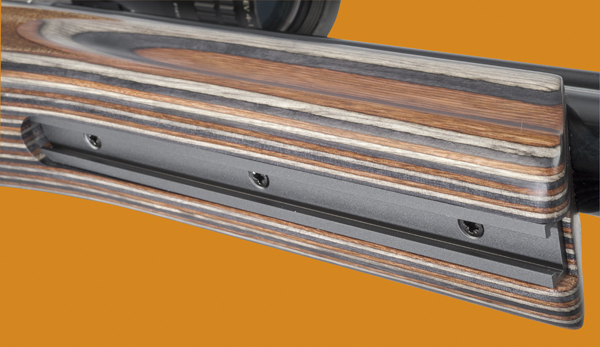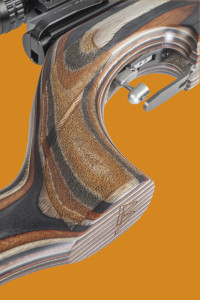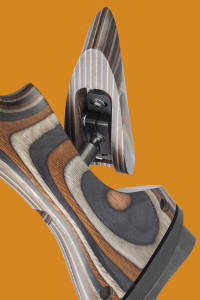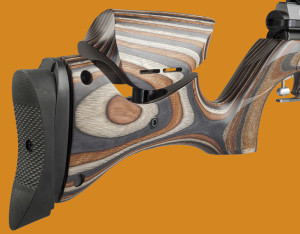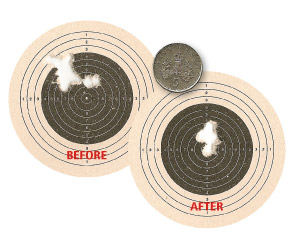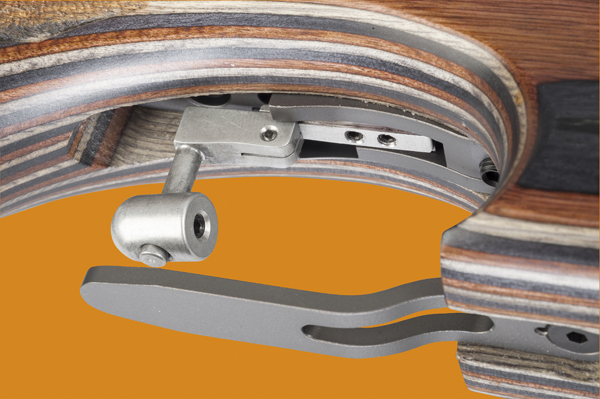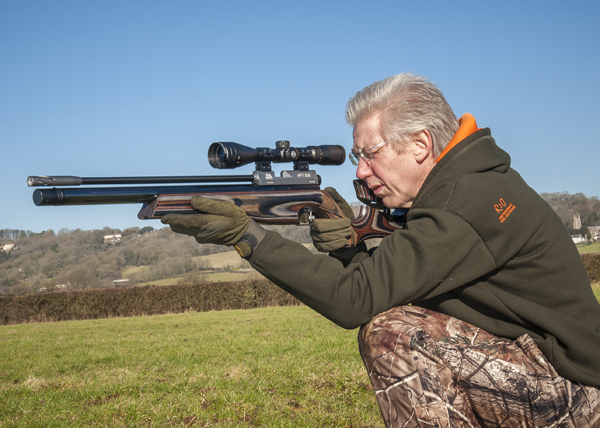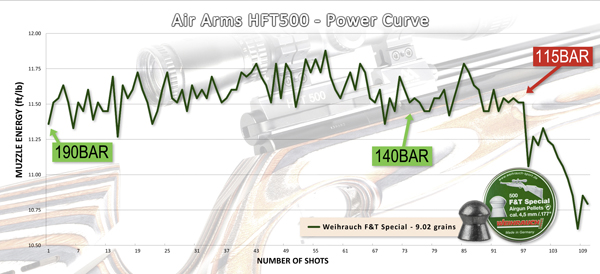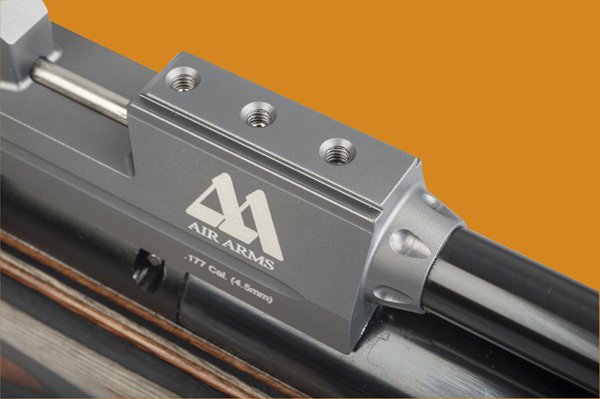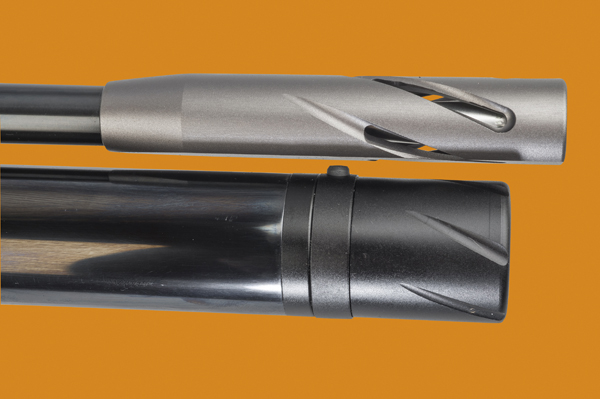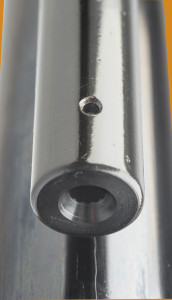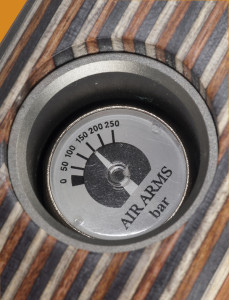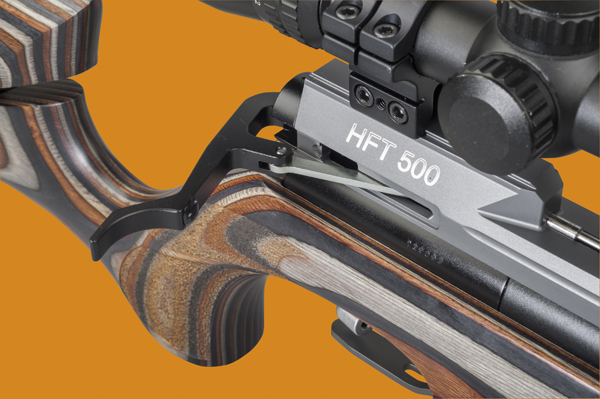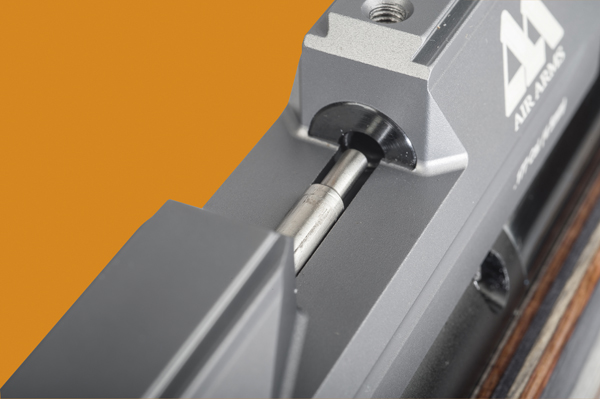Air Arms HFT500 PCP model: an air rifle that delivers both in field and target
Mike Morton delivers his verdict on Air Arms’ HFT500 PCP model
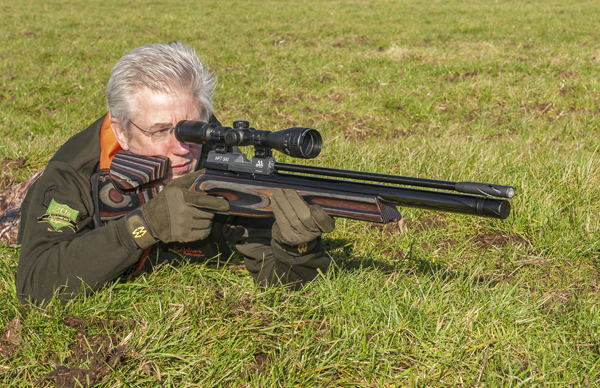
The Air Arms HFT500 PCP has been designed and named after the precision sport of Hunter Field Target.
Although Air Arms’ range spans the entire gamut of airgun shooting sports, the common thread that runs through it is, for me, one of precision. And while some may think that’s a hardware trait looked for only by target-orientated shooters, most serious hunters will tell you that it’s pretty much the prerequisite of a sporting air rifle, too.
Nonetheless, the Air Arms HFT500 is a dedicated outdoor competition model. A single-shot PCP – the Hunter Field Target derivative of the S510 series, the sidelever model that stands alongside the hugely successful S400/S410 series of rifles which has built up a fine reputation among field and target shooters alike. (Read our list of the best air rifle compressors.)
The third of Air Arms’ PCP releases, the HFT500 wears the same, Minelli-made laminated woodwork colours with which the Sussex gunmaker dresses its FTP900 field target and S510 Ultimate Sporter rifles. It’s a colour scheme that’s exclusive to Air Arms – and it’s not only very nice on the eye, but it’s been shaped to suit the specific discipline each model is designed for.
In the HFT500’s case, the woodwork is very close to the Ultimate Sporter’s; it has a target-styled forend complete with accessory rail, a sporter grip and a butt that features a multi-adjustable cheek and shoulder pad.
The forestock sports a flat underside with a slight belly swell in front of the ‘open’ trigger guard, and Air Arms will shortly be providing an optional, tailor-made ‘hamster’ for the accessory rail to increase the depth still more. For those au fait with the HFT rulebook, I can confirm that the hamster will fall within the regulatory 150mm limit between the bore centre and its base. (Read more on the hamster here.)
There is stippling on the forend, though the small panel is more for aesthetics than practicality. The side scallops offer both, however, and the two-panel stippling on the grip is very useful, providing a good ‘key’ for your palm. Trigger hand position is further aided by a rake that’s well suited to the holds encountered on HFT courses – it’s sporter all the way, but with enough of a hint of target to assist in a good trigger attack. Whether you shoot with your trigger hand’s thumb ‘up’ or ‘round’, the grip is very accommodating.
While the front end of the HFT500’s handle offers little in the way of adjustment, the rear can be modified in just about every direction to provide the perfect head alignment to the scope.
By way of a 4mm hex key, the cheekpiece can be raised or lowered via a pillar that also incorporates a ball joint around which the top section can be pivoted in all planes; simply slacken two 3mm hex-headed bolts reachable through slits. The cheek can even be adjusted in the lateral plane (thereby achieving stock ‘cast’), though this adjustment ideally needs to be undertaken with the cheekpiece section fully removed from the butt.
To finish off, the curved butt pad can be adjusted for height by simply undoing a posi-headed bolt – a hex-head would have been more consistent – and length of pull can be catered for by inserting spacers between the laminate butt and the rubber pad. In short, even the oddest-shaped person will be able to achieve the ultimate in gunfit with the HFT500, and I have to commend Air Arms for giving the shooter every possible advantage in this respect.
Ironically, I found the rifle’s rear end so ergonomic that all I had to do was raise the cheek to suit my aiming eye’s alignment with the BKL-mounted Hawke 4-12×40 Panorama EV scope that I fitted. But if only the trigger had been so easily to my liking…
Admittedly, my test sample was collected from Air Arms at the British Shooting Show, where the rifle had been on display – so I’ll accept that its trigger set-up had probably been ‘public-proofed’. However, my first outing with the gun highlighted a very poorly adjusted trigger unit, with a short first stage and a let-off that was more creepy than some budget-end springers.
Of course, I know Air Arms’ triggers are usually quite exceptional, and given the HFT500’s design is the same as the S510’s (though with a slightly different chassis), I made reference to the excellently detailed user manual to effect some changes. Suffice to say that I ended up getting its operation to be just so, adjusting out all that creep and getting a longer first stage.
Interestingly, my long distance groups prior to adjusting the trigger were still good: on a wind-free indoor 44-yard range, I would typically print 20mm groups. I wasn’t unhappy with that, but felt the firing cycle and ‘feel’ of the rifle could still return tighter clusters. As you can see from the targets above, once I’d got the trigger better set up, my group sizes halved, and I was then easily able to achieve 10mm groups from a good batch (circa 2006) of Air Arms 4.52 Diabolo Field. (The improvement in performance with nothing more than trigger adjustment was, actually, quite an eye-opener for me.)
As well as plenty of adjustment for sear engagement, and first and second stage weight, Air Arms have gone a little ‘left field’ with their HFT500’s trigger. The ‘blade’ can be moved fore and aft, but rather than a conventional flat-faced blade, they’ve fitted a ‘button’.
Apparently, this is to satisfy the current fashion among competition shooters – but I have to say I hated the feel of its bullet-shaped profile, preferring to turn it around to use the flat, circular face which, to me, felt more ‘normal’.
By way of a hex grubscrew, the button can be set high or low on its support bar, and angled to suit the pad of your index finger – but if you really can’t live with it, the blade from the HFT500’s S400 MPR-FT predecessor will fit (and Air Arms have a few of them in stock). The only thing about the trigger that didn’t impress me was its looseness; when the rifle’s not cocked, it rattles back and forward. I’d have preferred to see it under some sort of spring tension, but this in no way impinges on its flawless operation, once correctly set up.
Despite all its features for bespoking, the HFT500 certainly feels a long rifle, with a balance point (even when scoped) that sits ‘forward’ – a characteristic that many target shooters prefer, of course. When shooting from prone, it wasn’t an issue for me, but I felt that the gun tended to ‘catch the wind’ when I took aim at standers and kneelers.
I spoke with Air Arms’ technical boss who told me the length has been arrived at after much feedback from HFT shooters – and, I should add, not just those who use Air Arms guns. The Sussex-based gunmaker puts a lot of effort into seeing what the market wants before finalising any production rifle which, I guess, is why their stuff is always on the money when it finally arrives to market.
What Air Arms found HFT shooters really wanted was a longer sweet spot without the use of complicated air regulators – they’re just another thing to go wrong, it would seem. By ‘longer sweet spot’, they mean the portion of the charge cycle that has the least deviation from one shot to the next – in other words, a flat power curve between fill-ups of air. And the best way to deliver, say Air Arms, is with a longer action – one that utilises a greater air capacity.
By slightly tweaking the settings arrived at in the physics of the S400 and S510 designs, Air Arms have been able to fine-tune the balance between the main valve, hammer and transfer port to achieve a claimed 90-shot return from a 190BAR fill pressure – with, they tell me, around 60 shots recording velocity outputs on a very flat plateau. This they couldn’t achieve from a shorty.
You can see the results of my test rifle’s charge cycle below – and considering it’s technically an unregulated PCP, I’d say it beats the manufacturer’s claim in terms of shot-count and flatness of curve. I say ‘technically unregulated’ because the HFT500’s design does, actually, incorporate a kind of secondary air chamber between the main air reservoir and firing valve – Air Arms call it ‘the pot’ – which serves to release a consistent volume and pressure of air with every shot. Effectively, it’s a pseudo-regulator… but without all the complexity of a real one.
Consistency, of course, is one of the many important ingredients in the accuracy recipe – and the HFT500 doesn’t fall short anywhere in that mix. The 483mm-long barrel is from Lothar Walther, specially selected and match grade. However, there’s more to it than meets the eye, because it’s manufactured to higher tolerances and fits the HFT500’s breech block with a longer than usual engagement by way of an extra screw and integral fluted knuckle. All this additional support ensures the security of the totally free-floating barrel arrangement.
Why free-float a barrel? Well, precision-minded competition shooters will tell you that it dispenses with any tension that a holding collar may otherwise induce as the rifle proceeds through its charge cycle. Pressure changes will cause the cylinder to expand and contract, so if the barrel can be independently be removed from this equation, all’s the better.
There is a small rubber button set into the top side of the inlet valve assembly to stop the barrel rattling, but more eye-catching is the air stripper that sits at the end of the Lothar’s muzzle – the latter being choked and finished off with a heavily-recessed crown. The grubscrew which holds the air stripper in place locates into a deep pilot hole, meaning that the stripper’s position is not user-movable. The reason for this is that Air Arms have, through countless hours of testing, concluded that while an air stripper brings many benefits, an incorrectly set one can actually have a negative impact on accuracy.
They’ve found that there’s only a small ‘window’ in the muzzle/stripper relationship in which all the turbulent air is cleared away from the pellet at the start of its flight. It therefore makes good sense to go with their findings, rather than you risk cocking things up with over-enthusiastic use of a hex wrench.
The air stripper is finished in a beautiful satin-grey anodising which matches the breech, trigger guard and accessory rail – and as well as being the perfect complement to the stock’s laminates, it’s also a hue which is exclusive to Air Arms from their anodisers. It reminds me very much of the original ‘target’ PCP rifle Air Arms produced with their S100 series of PCPs back in the late 1980s – my own NJR100 had a silver-finished breech and muzzle brake which, at the time, was quite radical.
The fluted, screw-off cover under the muzzle reveals Air Arms’ belt-and-braces T-lock charging system – adaptor supplied – which also sports a sintered bronze filter to stop dirt ingress getting into the filler valve. Secreted in the forend, suitably finished off in an anodised grey collar, is a manometer – although Air Arms haven’t followed their avant-garde approach as with the Ultimate Sporter’s gauge, preferring a more traditionally marked facia. While it offers a good guide as to the HFT500’s current charge status, I’d still recommend filling to your air bottle/pump’s gauge; besides, it’ll be a lot easier to see. (Read our tips on how to shoot your air rifle accurately.)
Cocking and loading is a delight. The HFT500 runs the sidelever system that Air Arms perfected on their S510 model. There’s hardly any spring tension in the cocking cycle, and when drawn back, the bolt exposes an amply sized loading bay and channel into which you drop your .177 pellet.
The HFT’s bolt is ‘naked’; the O-ring seal is internally rebated into the bore to minimise wear and maintain a perfect probe-to-pellet feed. You can certainly ‘feel’ the pellet into the rifling, too – a trait that many competition shooters prefer to have in a loading system.
Although I tested this rifle mainly with one batch of AADFs, I could certainly feel differences in the feed when I tried a few other brands during my initial trials; Weihrauch Magnums, for instance, were a much ‘tighter’ push-in, while Webley AccuPell FT seemed to breech with hardly any push. (For the record, both returned 5p size groups at 44 yards, though.)
Casting a critical eye over the rifle’s finish really does serve to the quality of Air Arms’ engineering. The polish and blueing of the steel metalwork is impeccable, while the anodising is both even and aesthetically pleasing. There’s not a sharp corner to be felt anywhere, nor a file mark to be seen. Outwardly, it’s a very reassuring sign of how the rifle’s innards will have been machined – and when you’re lining up a target on the firing line, the peace of mind that brings translates to an extra target on your scorecard.
Yes, Air Arms HFT500 is a competition-biased rifle – but if a magazine-feed isn’t the be-all and end-all for you as a field shooter, I can honestly say that this rifle, perhaps with a bipod fitted to the accessory rail, would also make a phenomenal sniping tool for taking out long-range quarry.
When you think about it, Hunter Field Target is effectively ‘simulated’ hunting – and who’s to say you need a reset cord and marshal behind you to experience the thrill of knocking over a 45-yard rabbit? If you wanted the one rifle to double for both field and target, the HFT500 is without doubt an airgun that can deliver on both fronts.
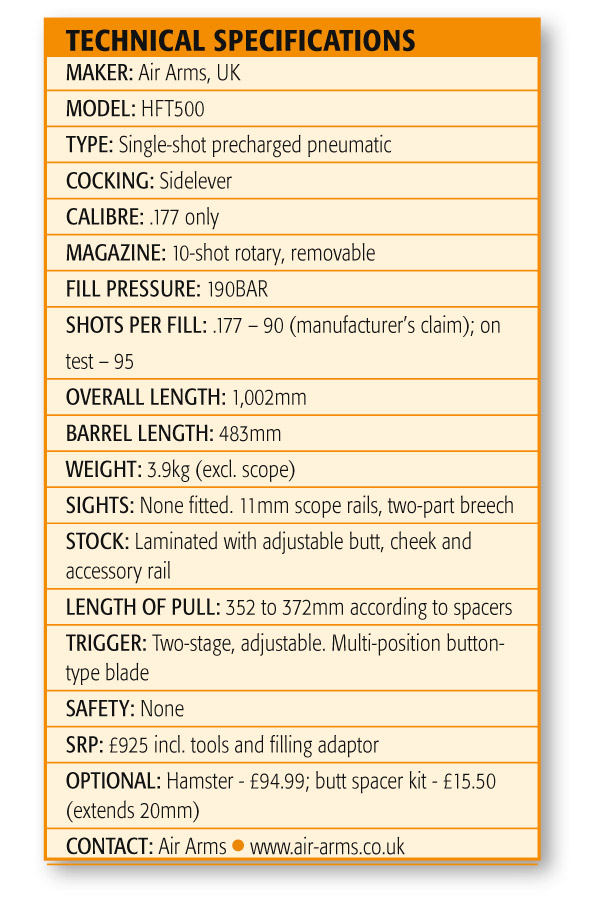
This review was originally published in 2015 and has been updated.
Verdict
If you wanted the one rifle to double for both field and target, the HFT500 is without doubt an airgun that can deliver on both fronts.

